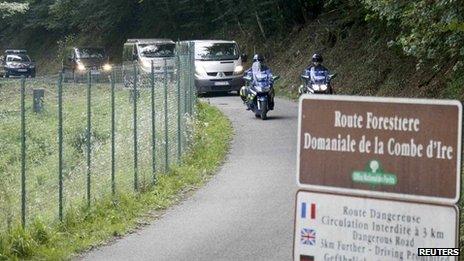French shootings: What happens in the aftermath of murder?
- Published

Photography then forensics are the first steps in the standard sequence of events in the investigation of a murder
What exactly happens at a murder crime scene behind those taped-off barriers saying "Police. Do not cross this line"?
There are variations between different countries and police forces, but a veteran forensic co-ordinator from the Metropolitan Police has explained to the BBC the standard sequence of events in a murder investigation such as the one triggered by the shootings in the French Alps on Wednesday.
The first priority in such an investigation is the photography, the "frozen-in-time" snapshot of exactly what is visible at the scene of crime.
This allows detectives to reference backwards over the coming weeks and months, long after the evidence has been moved and removed.
Then in go the forensic experts.
Wearing white forensic suits, the crime scene investigators will conduct what is called "a safety search" of the individuals, checking for anything harmful.
Forensic scientists will then conduct a painstaking search for any residues that could give up clues, especially for anything discharged from the murder weapon, in this case believed to be an automatic or semi-automatic pistol.
Gathering DNA is a top priority.

French police have sealed off the crime scene near Chevaline
They will take sterile swabs around the site of any wounds.
Using sterile swab kits, forensic scientists in cases similar to the one near Annecy would be expected to take samples from the car door handles, the steering wheel, the mirrors.
In a process known in the trade as "super-glueing", the vehicle would normally be sealed in a forensic bubble so as many fingerprints and other clues can be uncovered as possible.
Background intelligence also plays a part. By now, more than 24 hours since the murders took place, the French authorities will have asked Britain for anything known about the murdered family.
The Iraqi family connection will doubtless prompt a call to MI6, the British secret intelligence service.
Any suspicion of a link to terrorism would prompt the involvement of the Metropolitan Police's Counter Terrorism Command, known as SO15.
Given that the murders took place on French soil, albeit just 12 miles from the Swiss border, the French police are leading the investigation.
But if such a crime had occurred in Britain then, said the police detective, it would be a job for Homicide Command, more formally known as Scotland Yard's Serious Crime & Homicide Division.
- Published4 November 2013
- Published6 September 2012
- Published6 September 2012
- Published6 September 2012
- Published6 September 2012